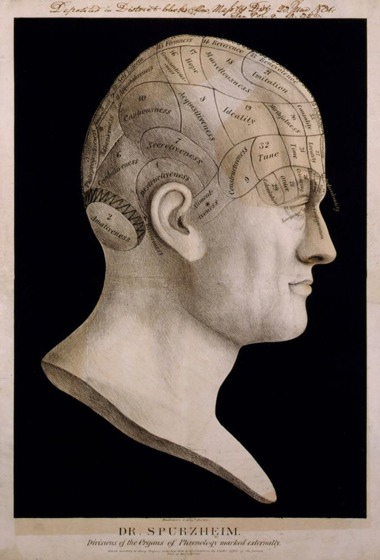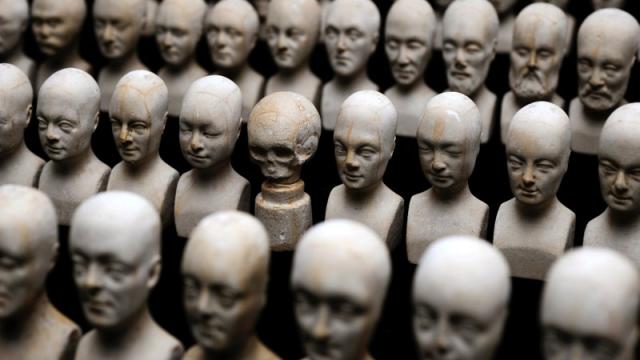These creepy miniature heads — 60 in all — are a fascinating relic of a short-lived fad in the 18th century called phrenology. They’re currently housed at the Science Museum in London. Phrenology was basically a pseudoscientific approach to determining someone’s personality traits and intellectual capacity by feeling for bumps on that person’s head.
We owe the onset of phrenology to Franz Joseph Gall, who was a young medical student in Vienna when he came up with the idea. Legend has it that his insight stemmed from an inferiority complex: convinced that he was clearly far more intelligent than his fellow students, it frustrated him that others could nonetheless memorise far more information, more quickly, than he could. He noticed the students who were best at memorization all had bulging eyes and prominent foreheads. So naturally he concluded that this must be an indication of where the facility for verbal memory was located in the brain. You build up muscles with exercise and they bulge, so why shouldn’t exercising the brain give rise to bumps on the head?
Eventually he compiled “evidence” of many other telltale bumps (27 in all), insisting that he could “read” a person and determine key personality traits just by groping their heads. There were organs of Theft, Murder, and even one for Amativeness, an indicator of keen sexual appetite.

Gall called this new field cranioscopy. It was his protege, Johan Spurzheim, who dubbed it phrenology, expanded on the concept, and took his new and improved skull-reading pseudoscience on the road, including to the US. That’s when phrenology really caught on.
It was also Spurzheim who commissioned the creepy miniature plaster heads. Books and lectures were fine and all, but his growing circle of acolytes craved “hands on” 3D samples of specific bumps associated with personality traits, the better to hone their skills.
Enter an artist named William Bally,who was charged with scaling down an existing collection of plaster “Bally heads” — the casts were based on actual people (some alive, some dead), so no two little busts are the same. My personal favourite, as described by the Phrenological Journal of Miscellany in 1832:
No. 29 — A very short miserable forehead, unfit for the manifestations of superior intellect; with the organs of Acquisitiveness, Cautiousness, Reverence, Marvellousness, and Secretiveness, large, while those of Combativeness, Self-Esteem, Hope, and Benevolence, are small.
Phrenology was nonsense, of course. It didn’t take long, relatively speaking, for the field to be thoroughly discredited, but Gall did make one lasting useful contribution to science. He was the first to propose there might be a “parts list” for the human mind, whereby different regions of the brain would be linked to specific functions. That notion of “functionalized localisation” is a cornerstone of modern brain mapping.
Top image: Science Museum, London/Wellcome Images. Bottom image: Phrenology chart, possibly by Johan Spurzheim. Public domain.
